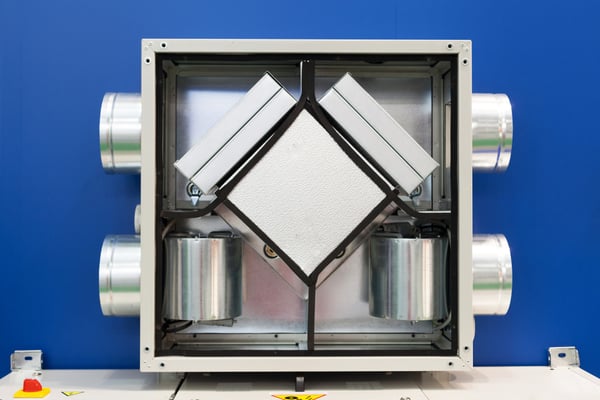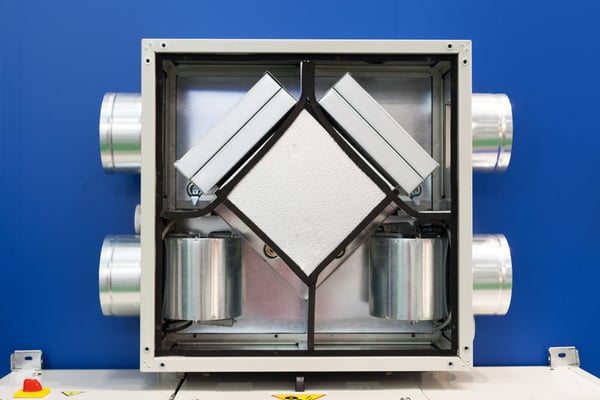Air handlers and other ventilation devices have much lower energy consumption than heating and cooling equipment. However, the operating conditions of a ventilation system have a significant impact on air conditioning and space heating loads. As a result, ventilation efficiency measures can improve the overall performance of an HVAC installation.
The air in most buildings is 2 to 5 times more polluted than outdoor air, according to the U.S. Environmental Protection Agency. Indoor air quality improves when a ventilation system increases the supply of outside air, except at times when the outside air is very polluted. However, a higher ventilation rate also means there is more air to cool or heat depending on the time of season. Energy efficiency measures for ventilation systems must optimize energy consumption, but without compromising air quality.
The following are some common ventilation measures that improve HVAC efficiency. They can be used together in a project, but it's important to understand their interaction:
- Demand-controlled ventilation (DCV)
- Energy recovery ventilation (ERV)
- Air side economizer
Reduce your heating, cooling and ventilation costs.
Demand Controlled Ventilation
DCV consists of reducing the ventilation rate according to occupancy. This not only reduces the energy consumption of the fans, but also the energy required to condition the outside air supply. For example, if the outside air is being cooled by 10°F and the airflow is reduced from 1,000 cfm to 500 cfm, the required cooling input will be reduced by about 50%.
The main disadvantage of DCV is that air pollutants can reach a higher concentration when outdoor airflow is reduced. ASHRAE standards provide a simple solution: establish a lower limit for outdoor air supply and configure the DCV system to never fall below that value.
DCV systems are typically controlled with carbon dioxide sensors, since occupancy can be correlated with the CO2 concentration in the air. However, the system can be enhanced with sensors to directly detect air pollutants. In this way, airflow can respond to air pollutants such as particles and volatile organic compounds. There is some correlation between occupancy and air pollution, but some sources are independent of the number of people. For example, freshly painted walls and new furniture release VOCs.
Ventilation with Energy Recovery

Energy recovery ventilation consists of the exchange of heat and moisture between the supplied external air and the exhaust air. There are many ways this concept saves energy:
- During the winter, when the inside of the building is warmer, the exhaust air can preheat the outside air supply with a heat exchanger. This reduces the space heating load.
- The opposite process applies during the summer, as indoor air can pre-cool the outdoor air. This reduces the load on the air conditioning.
- The system can also exchange moisture to reduce humidification or dehumidification loads. This applies when the outside air is very dry or very humid.
When an ERV system only exchanges heat, it is described as heat recovery ventilation (HRV). When there is also moisture exchange, a more accurate term is enthalpy recovery ventilation.
ERV and DCV can operate together without interfering. The DCV system determines the supply of outside air, while the ERV system reduces the heating or cooling load caused by this airflow.
Air side economizer
Heat sources in buildings can be internal or external. Indoor heat is typically released by occupants, appliances, and equipment. On the other hand, the main sources of outdoor heat are direct sunlight and hot air. Under some conditions, outdoor air is cold enough to compensate for indoor heat sources, and adequate temperatures can be achieved with ventilation alone. An airside economizer increases the outside air supply in these cases.
Economizers are unsuitable for hot and humid climates, since opportunities for free cooling with outside air are very rare. However, they can achieve significant air conditioning savings when the weather is right.
Unlike ERV systems, which operate independently of DCV, economizers compete with DCV. While a DCV system will attempt to reduce outdoor air supply in response to occupancy, the economizer will attempt to increase it to save on air conditioning. When DCV and an economizer are deployed together, the control system must be intelligent enough to detect which of the two economies is greater.
- When the air conditioning savings provided by the economizer outweigh the potential savings from reduced airflow, the economizer must replace the DCV system.
- On the other hand, the DCV system should have priority when the opportunity to save by reducing air flow is greater.
An ERV system and an economizer do not interfere because they are mutually exclusive. When there is an opportunity to use the economizer, the outside air is colder than the indoor air. In other words, the indoor air cannot be used for pre-cooling and the ERV system becomes inactive.
Conclusion
DCV, ERV, and an airside economizer can contribute to HVAC efficiency. However, the effectiveness of each measure varies depending on building conditions and local climate. To identify the most appropriate energy efficiency measures, the best recommendation is to contact a professional HVAC engineering company.
DCV and ERV can normally operate together smoothly and can achieve synergy. On the other hand, the DCV and an airside economizer are in opposition, and a control system must give priority to the greatest benefit. Finally, an economizer and an ERV system – when the outside air is cold enough for the economizer, pre-cooling with indoor air is not possible.

